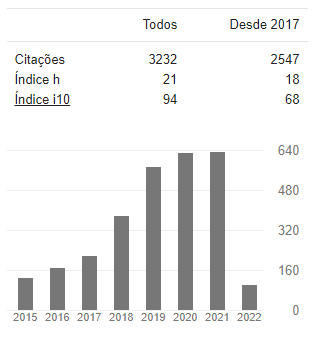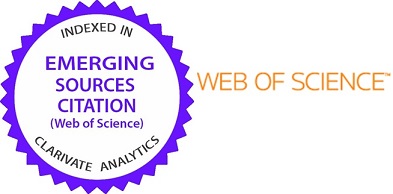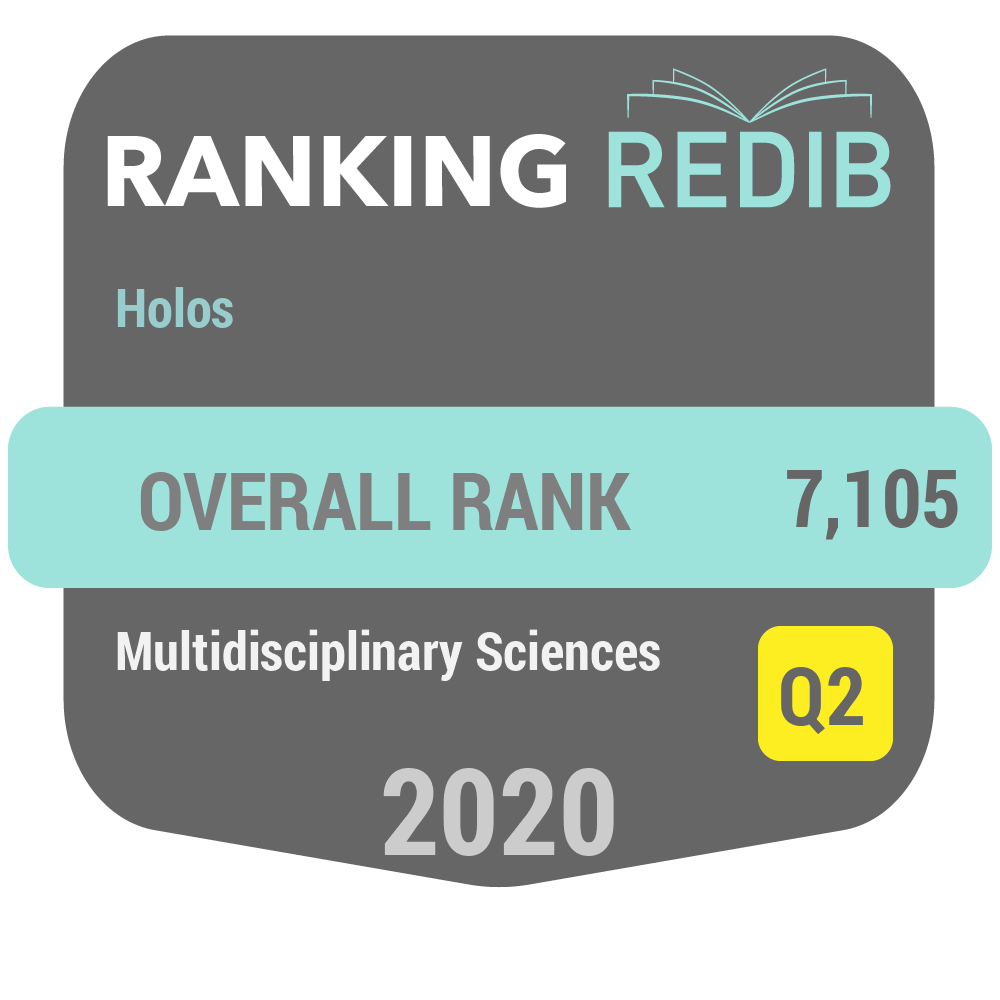RECUPERACIÓN DE COBRE CONTENIDO EN ESCORIA DE COBRE MEDIANTE FLOTACIÓN
DOI:
https://doi.org/10.15628/holos.2018.7118Palavras-chave:
escoria de cobre, recuperación, flotación.Resumo
Chile es el mayor productor de cobre en el mundo, y este metal es obtenido principalmente a partir de los sulfuros de cobre, utilizando los procesos clásicos de flotación y pirometalúrgicos. En nuestro país existen siete fundiciones de cobre, las cuales generan grandes volúmenes de escoria. Este trabajo presenta los resultados obtenidos de recuperación de cobre contenido en escorias de horno de reverbero (HR) y de convertidor Teniente (CT) de la fundición Hernán Videla Lira, de Paipote mediante flotación. A través de pruebas de flotación rougher a escala de laboratorio se determinó que la granulometría, para ambos casos, corresponde a 70% menor a 74 µm, lográndose recuperaciones de 59,2% escoria HR y 86,8% para la escoria del CT, cuyas leyes de cobre en el concentrado fueron de 3,7% y 23,6% respectivamente. Las dosis de reactivos utilizados fueron 40 g/t de F-703 como colector y 30 g/t de H-70 como espumante. Los tiempos óptimos de flotación de las etapas rougher y cleaner, de ambas escorias, se determinaron mediante cinéticas de flotación. Finalmente se realizaron pruebas a nivel industrial con los resultados de laboratorio alcanzándose una ley de 18,2% de cobre (recuperación de 56,1%) para escoria HR, y para la escoria CT se obtiene una ley de 39,1% de cobre con una recuperación de 91,4%
Downloads
Referências
Agar, G.E.; Stratton-Crawley, R.; Bruce, J. 1980. Optimizing the design of flotation circuits. Can Min. Metall. Bull. 73, 173-181.
Alexandrova, R, Paunova, R, Marinov, M and Petrov P 2014. Study on the behavior of flotation fayalite waste from copper production at nonisothermal heating. Journal of Chemical Technology and Metallurgy, vol. 49, no 1, pp. 90-93.
Altundogan, H.S., Tumen, F., 1997. Metal recovery from copper € converter slag by roasting with ferric sulphate. Hydrometallurgy 44, 261–267.
Antonijevica, M.M.; Dimitrijevic, M.D.; Stevanovic, Z.O.; Serbula, S.M.; Bogdanovic, G.D. 2008. Investigation of the possibility of copper recovery from the ?otation tailings by acid leaching. J. Hazard. Mater. 158, 23–34.
Biswas, A.K., Davenport, W.G., 1980. Extractive Metallurgy of Copper. Pergamon Press, New York, NY, USA.
Bradshaw, D., O'cornor, C.T., 1996. The flotation of low-grade pyrite ores using mixtures of collectors. Hidden Wealth. Johannesburg. Inst. Min. Metall. 89–96.
Bradshaw, D.J., Harris, P.J., O'Connor, C.T., 1998. Synergistic interactions between reagents in sulphide flotation. J. S. Afr. Inst. Min. Metall. 98 (4), 189–194.
Bradshaw, D.J., O'Connor, C.T., 1994. The flotation of pyrite using mixtures of dithiocarbamates and other thiol collectors. Miner. Eng. 7, 681–690.
Bulut, G. 2006. Recovery of copper and cobalt from ancient slag. Waste Manag. Res. 24, 118–124.
Davenport, W.G., King, M., Schlesinger, M., Biswas, A.K., 2002. Extractive Metallurgy of Copper. fourth ed. Kidlington, Oxford, England, Elsevier Science Limited, pp. 57–72.
Demetrio, D., Ahumada, J., Duran, M.A., Mast, E., Rojas, U., Sanhueza, J., Reyes, P., Morales, E. 2000. Slag cleaning: the Chilean copper smelter experience. J. Met. 52(8), 20–25.
Gonzalez, C., Parra, R., Klenovcanova, A., Imris, I., Sanchez, M., 2005. Reduction of Chilean copper slags: a case of waste management project. Scand. J. Metall. 35, 1–7.
Gorai, B.; Jana, R.; Premchand, M. 2003. Characteristics and utilization of copper slag—A review. Resour. Conserv. Recycl. 39, 299–313.
Guo, Z., Zhu, D., Pan, J., Wu, T., Zhang, F. 2016. Improving Beneficiation of Copper and Iron from Copper Slag by Modifying the Molten Copper Slag. Metals 6, 86, pag, 1-17.
Hayes, P.C., 1993. Process Principles in Minerals and Materials Production. Hayes Publishing Company, Brisbane, pp. 173–179.
Herreros, O., Quiroz, R., Manzano, E., Bou, C., Vinals, J., 1998. Copper recovery from reverberatory and flash furnace slags by chlorine leaching. Hydrometallurgy 49, 87–101.
Ip, S.W., Toguri, J.M., 1992. Entrainment behavior of copper and copper matte in copper smelting operations. Met. Trans. B-Process Met., 303–311.
Kim, B. S., Jo, S. K., Shin, D., Lee, J. C., Jeong, S. B. 2013. A physico-chemical separation process for upgrading iron from waste copper slag. Int. J. Miner. Process. 124, 124–127.
Las Fundiciones en la mira. Revista Minería Chilena 405. Marzo 2015
Mehta, K.D., Pandey, B.D., Permchand, M., 1999. Bio-assisted leaching of copper, nickel and cobalt from converter slag. Mat. Trans. JIM 40, 214–221.
Mihajlovi?, A., Kamberovi?, Ž., Kora?, M., Gavrilovski, M., Jovanovi?, N. 2015. The effect of cooling rate of slag from primary copper production in the valorization of copper in the flotation process. Metall. Mater. Eng. Vol 21 (2) 2015 p. 127-141.
Piret, N. L. 2000. Cleaning copper and Ni/Co slags: the technical, economic, and environmental aspects. J. Met. 52(8), 18–19.
Planta tratamiento de escorias de CODELCO avanza hacia ejecución. Portal minero. Consultada octubre 2017. http://www.portalminero.com/pages/viewpage.action?pageid=112920247.
Rao, G. V., Nayak, B. D. 1992. Flotation of copper from converter slags. J. Mine Met. Fuels 40(3–4), 131.
Rao, K.H., Forrsberg, K.S.E., 1997. Mixed collector systems in flotation. Int. J. Miner. Process. 51, 67–79.
Roy, S., Datta, A., Rehani, S. 2015. Flotation of copper sulphide from copper smelter slag using multiple collectors and their mixtures. Int. J. Miner. Process 143, 43–49.
Sarrafi, A., Rahmati, B., Hassani, H. R., Shirazi, H. H. A. 2004. Recovery of copper from reverberatory furnace slag by flotation. Miner. Eng. 17, 457–459.
Shen, H. and Forssberg, E. (2003). An overview of recovery of metals from slags. Waste Management. 23: 933-949.
Somerville, M., Norgate T., Jahanshahi, S., 2000. Single Stage Copper Making—Assessment of Slag Treatment Options, Proceedings Minprex 2000, International Conference on Mineral Processing and Extractive Metallurgy, The Australasian Institute of Mining and Metallurgy, Melbourne, pp. 453–459.









































